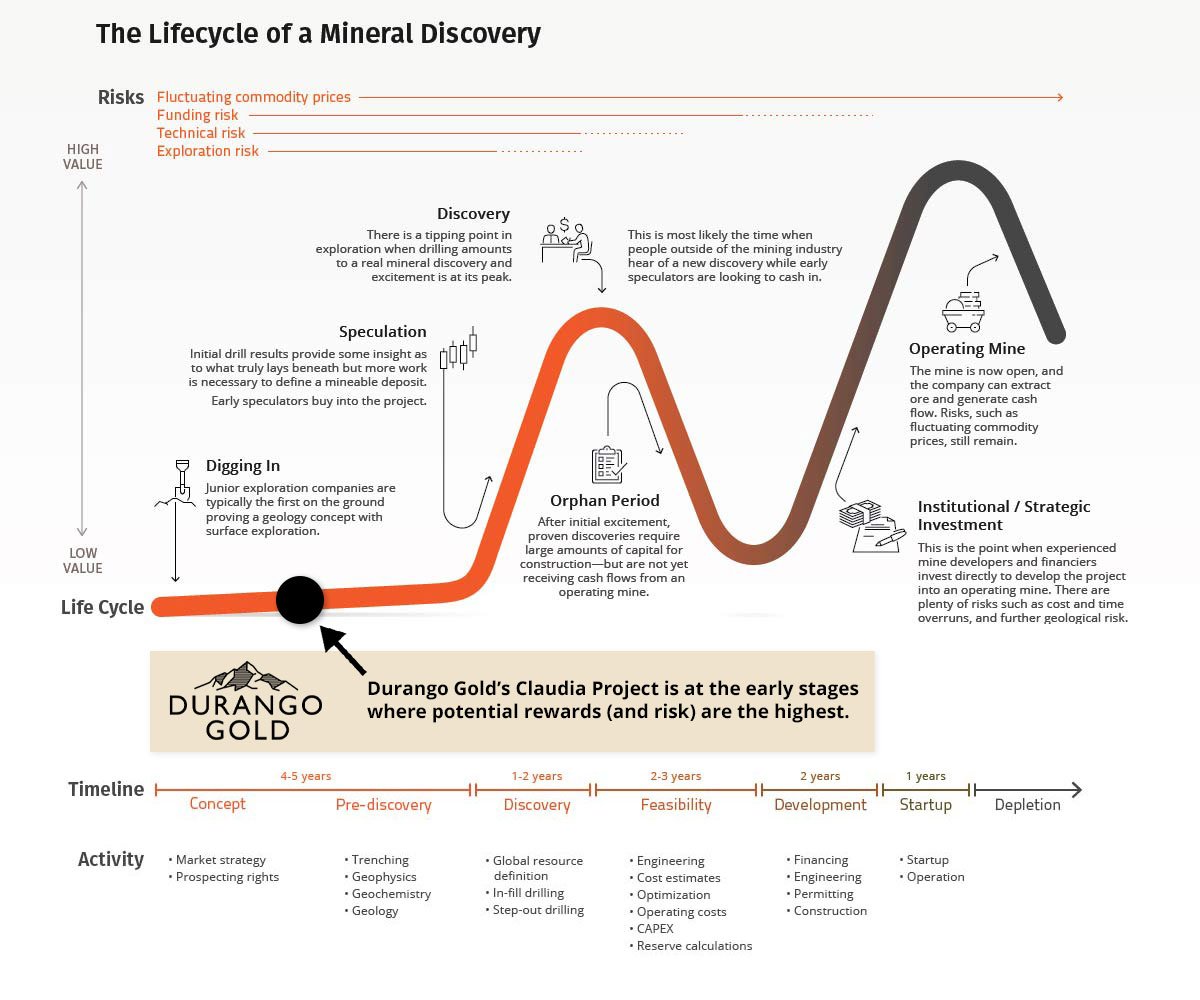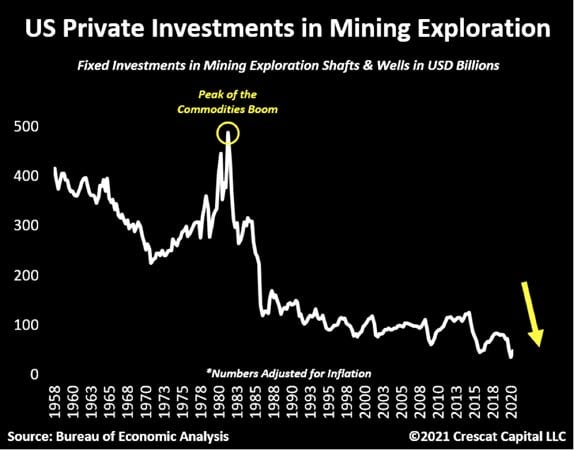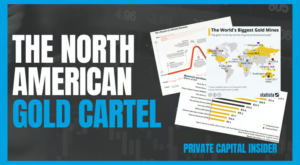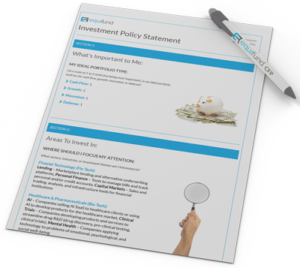You might imagine that digging gold out of the ground is an “easy money” industry…
But as the infamous quote from Mark Twain goes – “A gold mine is a hole in the ground with a liar standing on top of it.”
So, before you get swayed by the promises of six-digit winners from a speculative mining play…
It’s crucial you understand how these types of deals are structured… how valuations are determined… and (most importantly) how investors like us make money in these types of deals.
That’s why today, we’re going to discuss…
The Lifecycle of Mineral Discovery
Thirty years ago, Pierre Lassonde – a founder of Franco-Nevada, the first gold royalty company – created his now famous “Lassonde Curve.”
His model went on to become a touchstone in valuing junior miners.
The Lassonde Curve models the life of a mining company – from exploration to production – and helps investors gauge market value through each stage of the process.
This helps speculative investors understand the mining process, and time their investments properly.
The Lassonde Curve. 30 years old and still defining the junior mining industry
Beyond precious metals, the Lassonde Curve has become a staple across the mining industry.
The 7 Stages of Successful Mines
Successful mineral mines typically go through seven stages, each with their own risks and rewards.
As the process continues, more value is created for shareholders, and the project becomes less risky.
The seven stages are…
- Concept. The deposit is not much more than theory at this point. Geologists work to test the theory, locating the deposit – if it is there at all.The area is surveyed using a range of geochemical and sampling technology. When confident that the area might be mined profitably, they move to the next step in the process.
- Pre-Discovery. This is where speculative excitement can begin. Geologists coordinate test drilling to establish mineral potentials in the deposit area.The key method is taking below-ground cross-sections (drill core), and having them analyzed for mineral content. Drill cores with good mineral content can lead to further exploration, aimed at the discovery of a mineable deposit.
- Discovery. When exploration reveals ‘enough’ mineable minerals, new studies prove that mining could be profitable.This changes the business model creating new challenges, such as profitability, construction, and financing.
- Feasibility. Having demonstrated the deposit’s potential, investors then evaluate whether to advance the project.Speculators often pile in during this “orphan period” while uncertainties about the project remain keeping more conservative investors away.
- Development. A rare outcome, as most mineral deposits never make it this far. The next step is a production plan for the mine, including raising capital and building a team.Many risks still remain in the form of construction, budget, and timelines.
- Startup/Production. An even rarer outcome for a mineral discovery. The company begins processing ore and generating revenue.Management continue to re-rate the deposit, seeking additional from funds institutional investors and the general public.
Existing investors often choose to exit here or wait for potential increases in revenues and dividends.
- Depletion. While a rare few last centuries, most mines are depleted in a matter of decades.As grade levels decline, operations wind down, and the remaining investors seek exits.
But for investors new to precious metals plays, there’s something worth considering in this current “transitory inflation” period we’re allegedly facing…
The Case for Gold Companies
There are core differences between gold mining and other natural resource extraction industries.
Oil, in particular, is a high risk/high reward, often binary process. An oil driller either hits a gusher or they don’t.
Gold mining is different. It’s a more iterative process, averaging 10 to 20 years before potential mines start producing refinable ore.
As projects are pushed slowly up the value chain, ongoing iterations, mean that:
- Valuations of projects and companies can increase incrementally before actually building working mines.
- Miners can make realistic exploration and drilling budgets, without having to take on too much debt.
And that debt thing is an important for a number of reasons…
First… Miners are extracting a metal with a volatile price, making market conditions very difficult to predict.
Second… gold mining companies are having to look harder – and dig deeper – to find new deposits (the “low-hanging fruit” has been picked so to speak), all the while being under increasing pressure to minimize carbon emissions and environmental impact.
Third… the bigger a company gets, the more the administrative “red tape” grows, preventing them from being versatile enough to seize new opportunities.
As a result, Majors have underinvested in exploration, and in the 2010s began exhausting their existing reserves.
Investments in mining exploration are at a 62-yr low
The Majors strategy for fixing this problem is simple: growth through acquisitions.
You see…
- Most mines are discovered by explorers — people who use their skill, knowledge and expertise to find new deposits of rich ore.These are the “entrepreneurs” of the mining industry. And just like in the start-up space, explorers who have a track record of success – or have made discoveries before – are often more likely to repeat that success.
- Most mines, on the other hand, are developed by miners — small and large companies that don’t like to deal with the risk or difficulty of discovering and defining new gold or other metallic mineral resources.They’re really only good at extracting the stuff and will pay handsomely for projects that meet their criteria – kind of like how big conglomerates or tech companies buy-up small, more innovative firms (think Facebook buying Instagram, or Google buying YouTube).
That’s why in the 2010s the mining industry started to become consolidated – getting lean and mean by paying down debt, and cutting back on exploration and other expenses.
These changes highlighted how betting on major gold miners is totally different from betting on the physical metal. Successful gold miners offer some things that gold itself cannot, like:
- Dividends
- Cash
- Assets
- Income statements
- Balance sheets
And because of this, for investors who understand the business model there are ample opportunities in the mining space.
Yours for investing equality,
Jordan Gillissie – CEO
Equifund


